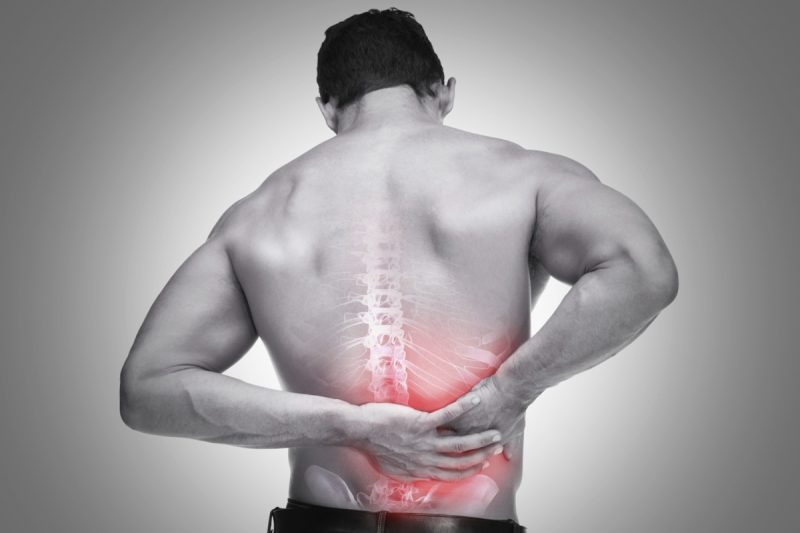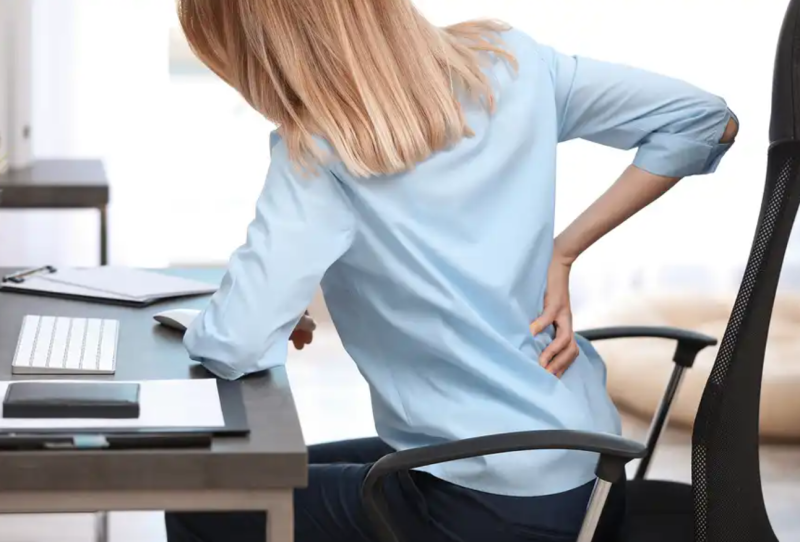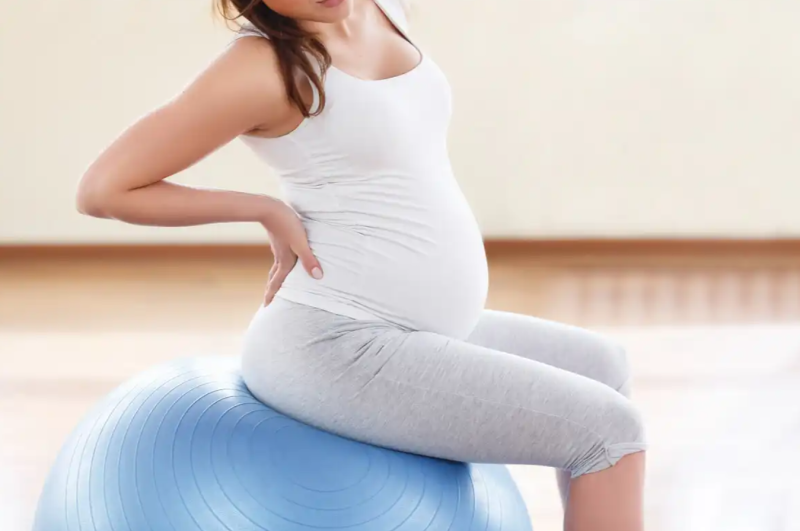
Pain is one of the main signs that something is wrong in the body. This can appear abruptly or gradually increase until it is incapacitating. Therefore, the appearance of pain on the right side of the lower back is a cause for concern for many people.
The kidneys are the abdominal organs that occupy most of the lumbar region or lower back, so pain in this area is often associated with kidney pathologies. However, these discomforts can also indicate conditions in nearby organs or tissues.
Contents
Seven causes of pain in the right side of the lower back
Low back pain, or lumbago, is one of the most frequent reasons for medical consultation. Studies establish that up to 80% of people will suffer from it at some point.
The most common causes range from muscle disorders to kidney problems. In most cases, it is due to mild to moderate conditions. However, less frequently, it can appear in serious illnesses requiring immediate medical attention.
1. Muscle problems
Muscular problems are one of the leading causes of lower back pain. According to studies, 90% of cases appear due to mechanical alterations, such as muscle tension due to improper posture or sudden movement.
Also, lifting heavy objects incorrectly can cause this pain to appear. The muscles in the lower back can be stretched and even torn when exerted too much on them.
Fortunately, conservative treatment usually has favorable results. Special exercises, physiotherapy, cryotherapy, pain relievers, and nonsteroidal anti-inflammatory drugs (NSAIDs) are the main treatment options. Do not hesitate to consult your doctor for an adequate approach.
2. Kidney diseases
Another frequent cause of pain in the right side of the lower back is kidney pathologies, specifically when they affect the right kidney. Infections and kidney stones are the most common conditions that cause this type of discomfort.
Kidney stones are solid deposits of mineral salts that form in the kidneys and move through the urinary tract. They cause significant pain in the lower back as they move, as they tend to injure the walls of the ureter. Studies affirm that the discomfort usually extends to the lower abdomen, groin, and genitals. Additionally, people may present with urgency to urinate, oliguria, or hematuria.
Treatment for this condition will vary depending on the size of the stone. Specialists can indicate medications that facilitate the exit of the same. Similarly, they can pulverize it with a shock wave technique or remove it by surgery.
On the other hand, urinary tract infections can ascend and affect the kidney, causing pain in the right side of the lower back. This condition is known as pyelonephritis. According to various studies, one of the most frequent etiological agents is E. coli. However, many bacteria in the gastrointestinal tract can cause this condition.
People with pyelonephritis present with tenderness on lumbar palpation, fever, burning with urination, foul-smelling urine, nausea, and vomiting. Fortunately, treatment with antibiotics makes it possible to resolve the condition. However, the infection can cause permanent kidney damage.
3. Spinal problems
Alterations in the vertebrae of the lumbar spine can also cause discomfort, of variable intensity, in the lower back. An example of this is herniated discs. These are produced by protrusion of the contents of the intervertebral discs into the spinal canal. According to research, the pain begins in the lower back and radiates to one of the legs when making an effort or pushing.
In general, people with a herniated disc respond effectively to conservative treatment. Medications used include pain relievers, nonsteroidal anti-inflammatory drugs, and muscle relaxants. In addition, it is complemented by physiotherapy and rehabilitation. Few patients require surgical resolution.
4. Appendicitis
The appendix is a portion of the large intestine located in the lower part of the right side of the abdomen. This portion of the intestine can become inflamed and cause a severe condition called appendicitis.
The pain of appendicitis usually begins in the upper abdomen. As the condition progresses, it migrates to the lower right part of the abdomen. Investigations affirm that in retrocausal appendicitis, the pain moves to the lumbar fossa and above the hip. The irradiation is because both areas share some nerve fibers.
Other common symptoms include malaise, nausea, vomiting, and fever. In addition, the discomfort tends to worsen with movements or after pressure in some specific regions.
The only treatment for appendicitis is surgical removal of the appendix. The procedure must be performed promptly because there is a risk of rupturing the organ and dispersing fecal matter in the abdomen.
5. Endometriosis
The endometrium is the inner lining of the uterus. It is a rapidly renewing epithelial tissue that is shed with menstruation and constantly renewed, preparing for a possible pregnancy.
Endometriosis is a gynecological condition in which the endometrium grows outside the uterus and may be in the fallopian tubes and ovaries. The expansion of this tissue towards other structures causes irritation and pelvic pain. According to research, the discomfort can sometimes occur at the lower back level.
Some studies estimate that this disease can affect between 2 and 10% of women worldwide. The hormonal approach with birth control pills can prevent the growth of endometrium in adjacent structures. It is also possible to remove excess tissue through surgery.
6. Pregnancy
Low back pain is one of the most common discomforts during pregnancy and can occur from the first trimester. According to studies, pain in the lumbar region appears due to increased estrogen and relaxin levels in women. These hormones are responsible for preparing the pelvis for childbirth, increasing the ligaments’ elasticity.
The increase in the size of the uterus and the baby during the second and third trimesters of pregnancy also cause discomfort in the lower back. The pain can be located on the right side of the lower back, depending on the baby’s position.
In addition, there is a readjustment in the center of gravity, so mothers change their posture and way of walking, which increases muscle tension and discomfort in the back. Treatment includes adequate physical therapy adapted to the limitations of pregnancy and the use of analgesic medications under strict professional indication.

7. Testicular torsion
Testicular torsion is a condition that most often affects boys. It occurs when the testicle turns on itself, which causes reduced blood flow to the organ. It is a true medical emergency since it can cause irreversible damage.
According to studies, the main symptom of testicular torsion is pain at the scrotal level, which can radiate to the lower abdomen or lumbar region. Swelling of the scrotum, nausea, and vomiting are also common manifestations.
Treatment of testicular torsion can be both medical and surgical. Specialists can try to reverse the torsion manually within 6 hours of the incident. After that time, it will be necessary to perform surgery.
When to visit the doctor?
Right-side lower back pain is rarely a medical emergency. However, it is always necessary to consult a specialist in the presence of new pain, especially if accompanied by other symptoms.
It is essential to closely monitor the characteristics of the pain and see if they change throughout the day. In this sense, a doctor should be seen in the event of the following manifestations:
- Pain is so intense that it prevents the performance of daily activities.
- Sudden onset pain that does not subside with the use of analgesics or anti-inflammatories.
- Persistence of symptoms for more than three days.
- Concomitant symptoms, such as fever, nausea, vomiting, and malaise.
Preventing pain in the right side of the lower back is possible
The most frequent cause of pain in the lower back is muscle problems due to stretching or tearing. These conditions appear when maintaining uncomfortable postures for a long time or when lifting heavy objects inappropriately. Fortunately, it is possible to prevent this discomfort.
This type of pain is usually alleviated with simple measures, such as taking painkillers or applying ice to the region. However, lower back pain can also be caused by medical emergencies such as appendicitis or testicular torsion. In this sense, it is always advisable to see a doctor.